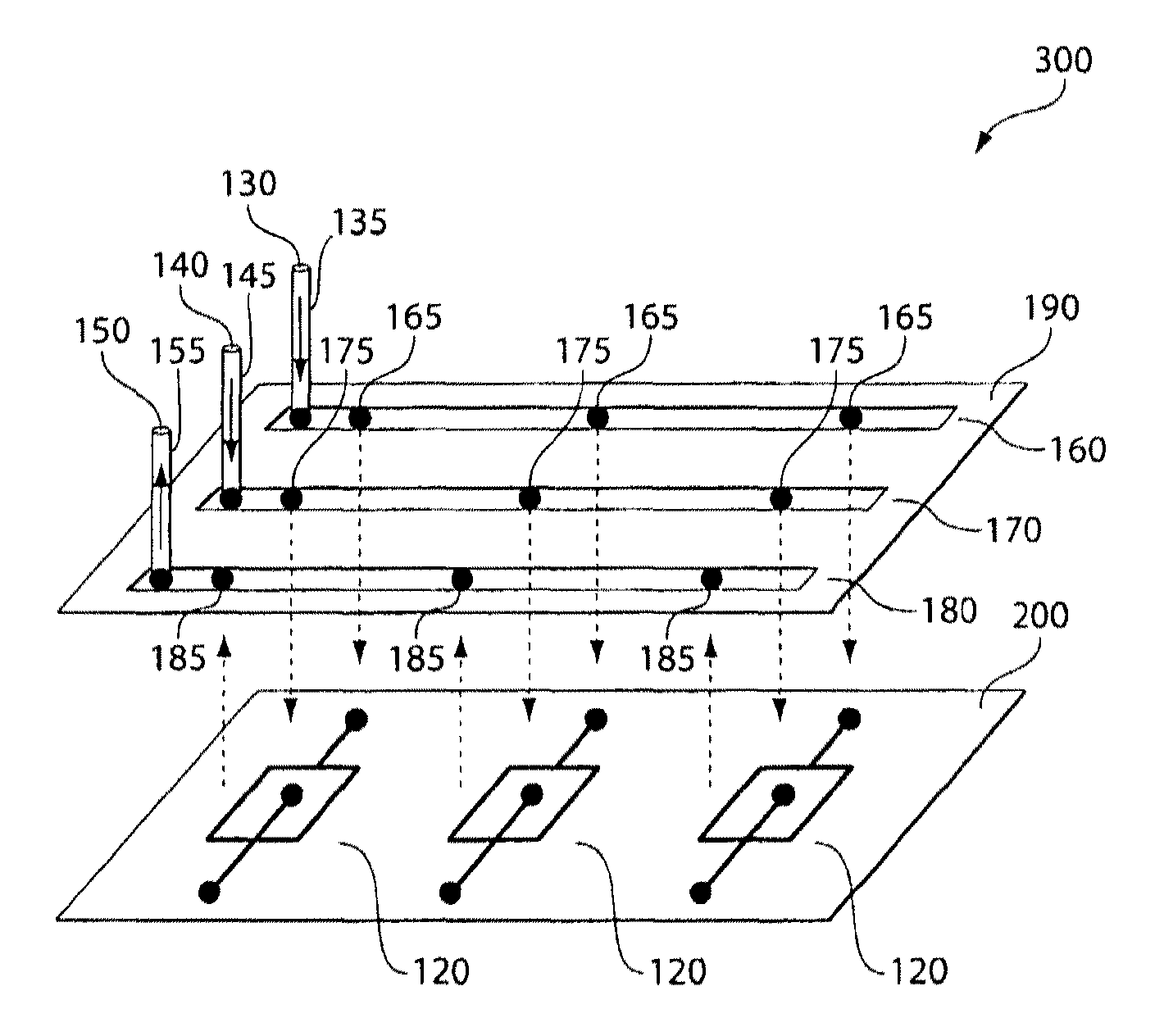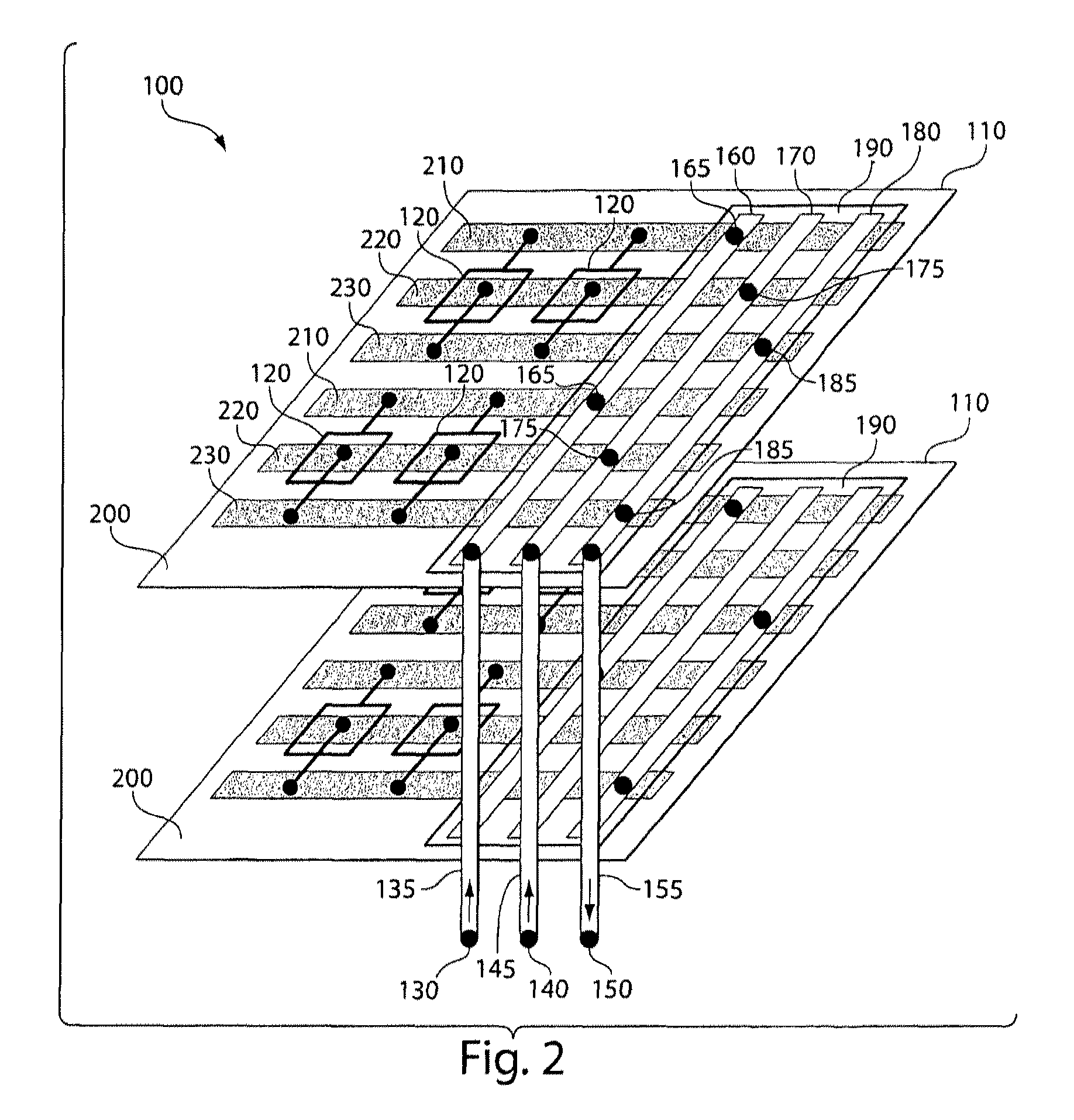Scale-up of flow-focusing microfluidic devices
a microfluidic device and flow-focusing technology, applied in the field of flow-focusing type technology, can solve the problems of affecting the accuracy of flow-focusing devices, prone to failure, and unsuitable control of very small dispersed phase droplets, and achieve the effect of preventing the pressure change from affecting another device and avoiding pressure fluctuations
- Summary
- Abstract
- Description
- Claims
- Application Information
AI Technical Summary
Benefits of technology
Problems solved by technology
Method used
Image
Examples
example 1
[0117]This example demonstrates the fabrication of a parallel drop formation system.
[0118]An array of microfluidic drop formation devices was fabricated from PDMS (polydimethylsiloxane) using standard multilayer soft lithography. The fluidic channels were arranged in a PDMS layer to have solid walls and ceilings but open floors. Fabrication of the channels was completed by bonding the channel-containing layer to a base of glass or PDMS. A channel in one layer can be connected to a channel in an adjacent layer by punching a hole in the ceiling of the lower layer channel.
[0119]In this example, the bottom-most layer contains an array of microfluidic devices, which are not connected together within this layer. This device layer was plasma bonded to a glass slide coated with a thin layer of cured PDMS elastomer.
[0120]On top of the device layer was bonded a first distribution channel layer containing an array of fluidic channels, with spacing that matches that of the inlets in the device ...
example 2
[0124]This example demonstrates the calculation of channel dimensions for a parallel microfluidic device.
[0125]As a sample calculation, the desirable channel dimensions to serve a 5×5 array of T-junctions producing simple emulsion droplets was estimated using the following equation, which is known in the art:
R=[(12*μ*L) / (w*h3)]*{[1−[(192 / π5)*(h / w)]]−1},
where “R” is the resistance in a rectangular microchannel, “μ” is the fluid viscosity, “L” is the channel length, “w” is the channel width, and “h” is the channel height. T-junctions with channel length 4000 μm, width 50 μm, and height 25 μm, have resistance of about 100 kPa*s / μL assuming a viscosity of μ=1 mPa*s. If the first-generation distribution channels have height 150 μm, width 1500 μm, and the distance between adjacent devices is 10,000 μm, then the resistance per segment is Rc1=0.2 kPa*s / μL. This affords equal flow division between the 5 devices at the 1% accuracy level. For the second-generation distribution channels, increa...
example 3
[0126]This example demonstrates parallelization of double emulsion formation.
[0127]Each dropmaking unit included two sequential cross junctions as shown in FIG. 12. An array of units was molded in one monolithic block of PDMS using standard soft lithography. Inlet and outlet holes were hand-punched, and plasma bonding was used to seal the microchannels to a glass base plate. Plasma bonding was again used to seal a layer of distribution channels onto the array. To make the channel surfaces in the devices hydrophobic for drop formation, the assembled device was flushed with Aquapel (a commercial auto glass treatment) and purged with air. The device was baked for several hours to dry the remaining Aquapel.
[0128]To produce double emulsions, the following fluids were injected through the distribution channels: 1-octanol as the innermost phase, water with 0.5% (by weight) sodium dodecyl sulfate (“SDS”, a surfactant) as the shell phase, and HFE-7500 oil with 1.8% (by weight) “R22” surfacta...
PUM
| Property | Measurement | Unit |
|---|---|---|
| diameter | aaaaa | aaaaa |
| total flow rate | aaaaa | aaaaa |
| total flow rate | aaaaa | aaaaa |
Abstract
Description
Claims
Application Information
 Login to View More
Login to View More - R&D
- Intellectual Property
- Life Sciences
- Materials
- Tech Scout
- Unparalleled Data Quality
- Higher Quality Content
- 60% Fewer Hallucinations
Browse by: Latest US Patents, China's latest patents, Technical Efficacy Thesaurus, Application Domain, Technology Topic, Popular Technical Reports.
© 2025 PatSnap. All rights reserved.Legal|Privacy policy|Modern Slavery Act Transparency Statement|Sitemap|About US| Contact US: help@patsnap.com



